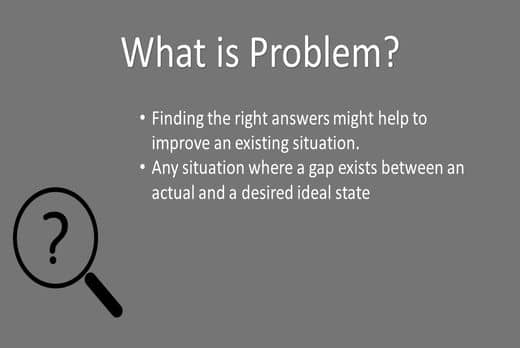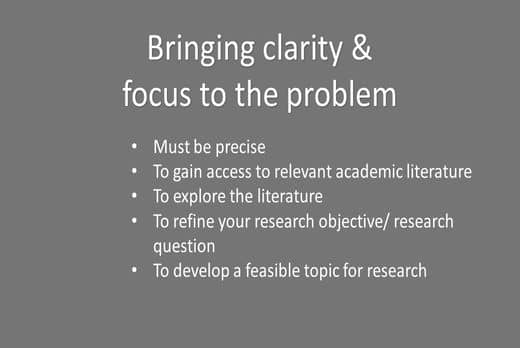Research problem is a term used to refer to different types of research projects, which are usually related to a single subject. Research problem is a term that is used in many fields of study. It is a specific type of problem that someone can test or observe.
From medical research to psychology, there are various uses of the word problem. But what exactly is a research problem?
It’s any scientific study that costs money to conduct or an academic article that has been peer-reviewed and published. These definitions will help you as a researcher avoid overthinking your research problem or making it too difficult for yourself.
If you’re looking for ways to define and refine your Research Problem, we have some great ideas for you! Read on to learn more about what Research Problems are and what they can do for your research study goals.
In this article, you will learn:
▶ How to Identify problem areas that are likely to be studied in organizations?
▶ How to use preliminary research to narrow down a broad problem into a researchable topic?
▶ How to develop a good problem statement?
Read More:
How Business Research is helpful for Managers? | Business Process | Types of Research
How to identify a Research Gap in Research Articles?
How to build Research Questions on the basis of Theoretical Model?
How to Write a Synopsis for Research
How To Write A Literature Review In Research: A Step-by-Step Guide
What is Problem?
A “problem” does not always indicate that there is an immediate need to fix something that is seriously wrong with the way things are right now. A problem could also indicate an interest in a subject where obtaining the correct solutions could help to advance the situation in general. As a result, it is useful to characterize a problem as any circumstance in which a gap occurs between an actual and an ideal situation.

Some problems that the manager might run into at work are listed below.
Example of Problems
⫸ Long and frequent delays lead to much frustration among airline passengers. These feelings may eventually lead to switching behavior, negative word‐of‐mouth communication, and customer complaints.
⫸ Staff turnover is higher than anticipated.
⫸ The current instrument for the assessment of potential employees for management positions is imperfect.
⫸ Minority group members in organizations are not advancing in their careers.

⫸ The newly installed information system is not being used by the managers for whom it was primarily designed.
⫸ Flexible working hours have generated more issues than they have solved.
⫸ Young workers in the organization show low levels of commitment to the organization.

⫸ To embark on our research journey.
⫸ To be transformed into a researchable topic for investigation
⫸ To be narrowed down to a researchable topic for study.
⫸ To translate the broad problem into a feasible research topic.

Read More:
What is Quantitative research? Types, Pros, and Con
Research Methods: Definitions, Types
Qualitative Research: Types and Methods
The Difference Between Experimental and Non-Experimental Research
Survey vs Questionnaire: What’s the Difference?
Problem
Examples of common problems inn Psychology include:
Self-esteem
In a research problem, you want to know if people’s self-esteem is affected by the things they do, like how they dress, how they use their brains, and what they think.
Humans are predators and prey. We are interested in things that other people are preyed on by. Research problems that examine the effects of media, social pressure, and certain disorders on people’s self-esteem can help you understand the importance of these factors for decision-making.
Mental illness
Research problems that examine the ways that mental illness can affect people’s perceptions of themselves can help you understand the importance of mental illness for decision-making.
Depressive people
Depressive or stressful-out people are people who are prone to mood fluctuations and who may need extra help managing their emotions. Research problems that examine the ways that depression can cause feelings of sadness, shame, and guilt can help you understand the importance of having this disorder for decision-making.
Bringing Clarity & Focus to the Problem
Identifying the key concepts in the original problem statement is the “secret” to helping your challenge gain clarity and focus. A broad, first description of the issue frequently uses a number of words and/or phrases that require explanation.

Take a look at the following issue:

“Members of minority groups in organizations are not moving up the corporate ladder.”
To identify the key terms in your problem statement, look for the subjects (careers), verbs (advancing), and objects (minority group members) in your statement. To determine the topic of the study and acquire access to relevant scholarly literature, definitions of essential terms must be clear. You can examine the literature if you have precise definitions. The literature review will help you to refine your research objective(s) and research questions and thus to develop a feasible topic for research.

- To isolate the key ideas in the first version of the problem statement
- Includes several words and/or phrases that need definition.
Example
To identify the key terms in your problem statement, look for the subjects (careers), verbs (advancing), and objects (minority group team) in your statement.

In order to identify the study topic and acquire access to relevant academic material, definitions of essential terminology must be clear. Precise definitions will allow you to explore the literature. The literature review will assist you in refining your research objective(s) and research questions, allowing you to come up with a viable study topic.
Read More:
Research Hypothesis | Step by Step Guide to Write Hypothesis
Design A Questionnaire for Research: 6 Steps to Get You Started
Cross-Sectional vs Longitudinal Studies: The Key Differences
Three Stages of Research Process

STEP 1 – Defining The Problem
You will have to divide your time early on in the research process between preliminary research (such as a first review of the literature) and (re)defining the problem statement. You cannot choose what information is useful until you have created a first rough problem statement. A more precise problem statement may prompt the need to gather additional information, which may direct you to reframe the problem statement, and so on. However, being aware of and comprehending current work and viewpoints in the field may alter your perspective on what the problem is and inspire you to refine the problem statement.

STEP 2 – Preliminary Research
Preliminary research should help the researcher to find answers to questions such as:
- What is the problem?
- Why does the problem exist?
- Is the problem important?
- What are the benefits of solving the problem?

Although the particular nature of the information required for this purpose varies depending on the problem being addressed, it can be broadly divided into two categories:
1- Information about the company and its surroundings, or contextual factors
2- Information on the topic of interest

STEP 3 – Defining The Problem Statement
The researcher is in a better position to clarify the topics of concern and narrow down the problem from its broad basis after gathering preliminary data. As we have already shown, it is essential that the problem statement be clear, precise, and focused, and that it be approached from a particular academic viewpoint. No amount of good research can find solutions to the situation if the critical issue or the problem to be studied is not clearly pinpointed.

What makes a good problem statement?
A good problem statement includes both a statement of the research objective(s) and the research question(s). Good research has a purposive focus.

Thus, the research’s goal or objective reveals why the study is being conducted. The research objective statement should be brief while still making the project’s focus clear.
Other articles
Please read through some of our other articles with examples and explanations if you’d like to learn more about research methodology.
Statistics
Methodology
- Research Methods
- Quantitative Research
- Qualitative Research
- Case Study Research
- Survey Research
- Conclusive Research
- Descriptive Research
- Cross-Sectional Research
- Theoretical Framework
- Conceptual Framework
- Triangulation
- Grounded Theory
- Quasi-Experimental Design
- Mixed Method
- Correlational Research
- Randomized Controlled Trial
- Stratified Sampling
- Ethnography
- Ghost Authorship
- Secondary Data Collection
- Primary Data Collection
- Ex-Post-Facto
Research
- Table of Contents
- Dissertation Topic
- Synopsis
- Thesis Statement
- Research Proposal
- Research Questions
- Research Problem
- Research Gap
- Types of Research Gaps
- Variables
- Operationalization of Variables
- Literature Review
- Research Hypothesis
- Questionnaire
- Abstract
- Validity
- Reliability
- Measurement of Scale
- Sampling Techniques
- Acknowledgements




3 Comments
Many thanks, I am always learning from your posts, videos (you tube), audios and varaities of pdf resources, I apperciate you. May I get a pdf copy of this article pls?
What i do not understood is if truth be told how you are no longer actually a lot more smartly-favored than you might be now. You are very intelligent. You understand therefore significantly with regards to this subject, produced me for my part consider it from numerous numerous angles. Its like men and women aren’t fascinated unless it’s something to do with Lady gaga! Your individual stuffs great. At all times handle it up!
May God Almighty help you out in the areas of your needs.
You have done good work that help a lot.
Thanks.
Adegboyega Adegboye